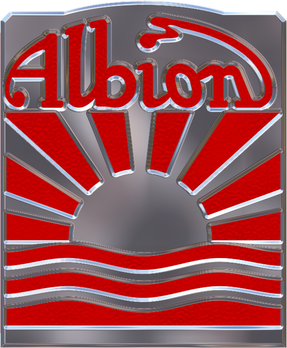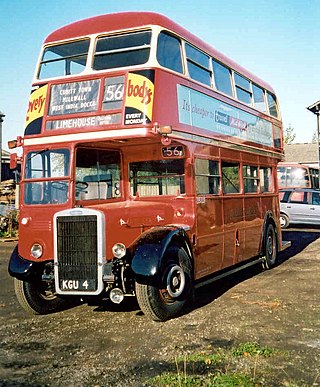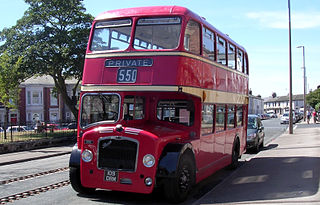
Albion Motors was a Scottish automobile and commercial vehicle manufacturer.

A midibus is a classification of single-decker minibuses which are generally larger than a traditional minibus but smaller than a full-size single decker and can be anywhere between 8 metres and 11 metres long. While used in many parts of the world, the midibus is perhaps most common in the United Kingdom, where operators have found them more economical, and to have a sufficient number of seats compared to full size single-decker buses.

The Leyland Titan was a forward-control chassis with a front-mounted engine designed to carry double-decker bus bodywork. It was built mainly for the United Kingdom market between 1927 and 1942, and between 1945 and 1969.

The Leyland Olympian was a 2-axle and 3-axle double-decker bus chassis manufactured by Leyland between 1980 and 1993. It was the last Leyland bus model in production.

The Leyland Atlantean is a predominantly double-decker bus chassis manufactured by Leyland Motors between 1958 and 1986. Only 17 Atlantean chassis were bodied as single deck from new.

The Bristol VR was a rear-engined double-decker bus chassis which was manufactured by Bristol Commercial Vehicles as a competitor to the Leyland Atlantean and Daimler Fleetline.

The Bristol Lodekka was a half-cab low-height step-free double-decker bus built by Bristol Commercial Vehicles in England. It was the first production bus design to have no step up from the passenger entrance throughout the lower deck; although Gilford and Leyland Motors had developed low floor city buses in the 1930s, these did not enter production.

Charles H Roe was a Yorkshire coachbuilding company. It was for most of its life based at Crossgates Carriage Works, in Leeds.

Bristol Commercial Vehicles was a vehicle manufacturer located in Bristol, England. Most production was of buses but trucks and railbus chassis were also built.
A lowbridge double-deck bus is a double-decker bus that has an asymmetric interior layout, enabling the overall height of the vehicle to be reduced compared to that of a conventional double-decker bus. The upper deck gangway is offset to one side of the vehicle, normally the offside, and is sunken into the lower deck passenger saloon. Low railway bridges and overpasses are the main reason that a reduced height is desired.

The Dennis Falcon was a rear-engined single-decker bus, double-decker bus and coach chassis manufactured by Dennis between 1981 and 1993. It was mostly built as a single-decker bus, although some express coaches and a small number of double-decker buses were also produced. The total number built was 139, plus one development chassis.

The Bristol RE was a rear-engined single-decker bus or single-decker coach chassis built by Bristol Commercial Vehicles from 1962 until 1982. It is often considered the most successful of the first generation of rear-engined single-decker buses.

The Bristol MW is a bus and coach chassis. designed and built between 1956 and 1966 by Bristol Commercial Vehicles in Brislington, Bristol.

The Leyland Tiger Cub was a lightweight underfloor-engined chassis manufactured by Leyland between 1952 and 1970.

The Leyland Panther Cub was a rear-engined single-decker bus manufactured by Leyland from 1964 until 1968.
The Albion Aberdonian was an underfloor-engined bus designed and manufactured by Albion Motors between 1957 and 1960, it was introduced as a longer derivative of the Albion Nimbus.

The Albion Nimbus was an underfloor-engined, ultra-lightweight midibus or coach chassis, with a four-cylinder horizontal diesel engine and a gross vehicle weight of six tons. It was largely operated on light rural bus duties and private hires. Operators who used it on heavy-duty bus routes found it insufficiently robust. It was the first Albion bus chassis to have a name that did not begin with the letter V. The design was revised twice and was produced from 1955 to 1965.

The Leyland Royal Tiger Worldmaster, sometimes simply known as the Leyland Worldmaster, was a mid-underfloor-engined single-decker bus or single-decker coach chassis manufactured by Leyland between 1954 and 1979.

The Bristol LH was a single-decker bus chassis built by Bristol Commercial Vehicles (BCV) in Bristol, England. Nearly 2,000 were built between 1967 and 1982 in a variety of sizes and body types, including some as goods vehicles.

The Albion Lowlander was a Scottish-built low-height double-decker bus.




















